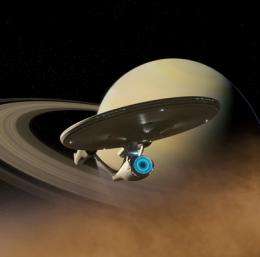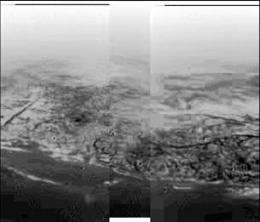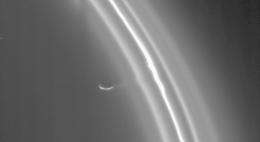Cassini Saturnalia

Six years ago, the Cassini-Huygens spacecraft began orbiting Saturn. Scientists are celebrating the data and detailed images the mission has provided of the planet, its famous ring, and its many moons.
In the latest outing for the Star Trek movie franchise, the young James T Kirk races the newly commissioned USS Enterprise at maximum warp speed back to the solar system. Kirk must rescue the Earth from the ravages of the driller killer machine that the maverick Romulan Nero has already used to destroy the planet Vulcan.
Ensign Chekhov suggests that they hide the Enterprise within the Saturnian system. In a memorable scene, Enterprise decelerates instantaneously from Warp 4 to impulse power and then, using its thrusters, emerges dramatically from the thick orange atmosphere of Saturn’s moon Titan. You feel like cheering - not only because the movie is ‘Trek’ at its best but because the script writers have got their planetary science right. Titan’s atmosphere is indeed like that, an ochre-colored soup of chemicals that is thought to resemble the atmosphere of the early Earth.
This year marks the sixth anniversary of the arrival of the Cassini-Huygens mission in orbit around Saturn and the fifth anniversary of the most distant landing on another heavenly body - the touchdown on Titan by the Huygens probe on January 14th 2005.
The Cassini-Huygens mission has its origins as far back as 1982, when the European Science Foundation got together with the US National Academy of Sciences to think about ways they could collaborate on space science. At that time the possibility of a joint mission to Saturn was suggested. The mission to Saturn was at least partly driven by the continuing interest in the largest moon of the Saturnian system - Titan - which had been previously visited by Pioneer 11 and both Voyager 1 and 2.
Further reports on the feasibility and desirability of a follow-up mission to Saturn followed, culminating with the influential 1987 report by astronaut Sally Ride on NASA leadership and America’s future in space that endorsed the Cassini-Huygens mission. Part of the interest in the Saturn system lay in the fact that Voyager and Earth-based measurements suggested that Titan might have an atmosphere similar in composition to that of the early Earth, before the rise of oxygen and multi-cellular organisms. An orbiter sent to Titan might even find itself examining an analogue of our planet before the dawn of life.
The Cassini-Huygens mission - at a cost of a little over three billion dollars the largest and most complex robotic spacecraft to the outer solar system ever devised - launched from Cape Canaveral on October 15, 1997. Measuring almost seven metres high and four meters wide, in unmanned spacecraft terms it was the marvel of its age. Onboard instrumentation included a synthetic aperture radar for mapping the surfaces of Saturn’s moons, an imaging system with both a wide and a narrow angle camera together with dedicated infrared and ultraviolet instruments capable of capturing high resolution images in the visible, infrared and ultraviolet parts of the electromagnetic spectrum, a magnetometer, and a mass spectrometer for analyzing the chemistry of the Saturnian system.
Because of the enormous distance of Saturn from the Earth, Cassini-Huygens’s flight required four gravity-assist maneuvers - two of Venus, one of Earth and one of Jupiter- to gain enough speed to reach the outer solar system within the time frame required by the mission profile. By late 1999 the spacecraft was heading out beyond the asteroid belt toward Jupiter. As it passed Jupiter it took over 26,000 images, producing the highest resolution portrait of the planet achieved to date with objects as small as 40 miles across clearly visible and, for the first time, providing details about the circulation of Jupiter’s atmosphere. The dark belts of Jupiter turned out to be areas of rising atmosphere while the lighter ‘zones’ between them were areas of sinking atmosphere.
Cassini-Huygens arrived in orbit around Saturn on July 1, 2004, having already discovered three new moons as it approached the ringed system. On Christmas Day 2004 the Huygens probe separated from the Cassini orbiter and began to drift towards Titan.
On January 14, 2005 Huygens began its two-and-a-half hour descent through Titan’s turgid atmosphere. It was then that disaster struck. The Huygens probe had been designed to transmit data back to Earth via two channels known as Channel A and Channel B. John Zarnecki, principal investigator for the Huygens Science Surface Package (SSP), says having two channels not only provided redundancy, but also doubled the rate at which the probe could collect data. During the probe’s descent, however, they discovered that one of the channels didn’t work.

“It did not affect (the SSP) one jot - we got all our data on the one channel,” says Zarnecki. However, other experiments which had been relying on the dual-channel capability lost half of their data. For technical reasons the Doppler Wind Experiment was fully allocated to the “bad” channel, so all that data was lost. However, the scientists were able to reconstruct most of this lost data by other means.
I asked Zarnecki what he thinks are the main achievements of the Huygens lander, now that it is over five years the since his craft set down on Titan. “Diversity,” he says. “It is the diversity that amazes me. We had no idea that we would see so many different things on so distant a moon.”
The Huygens probe showed that the surface of Titan has a diverse topography of, hills, mountains, rivers, lakes and seas. Zarnecki points out that the latter three are the product of the most prosaic of phenomena - rain. The only difference is that on Earth these features are made by the action of flowing water, whereas on Titan the equivalent features are made by the action of flowing liquid methane. It is this contrast that intrigues Zarnecki - the similarity of features caused by a similar process, yet with different raw materials.
Carl Murray of Queen Mary, University of London echoes Zarnecki’s enthusiasm for the diversity of Titan, but also points out that quality is not limited to just one moon of Saturn.
“I think that the diversity of objects seen up close by Cassini and Huygens has been crucial,” says Murray. “The observations of Titan have been amazing, but the fact that we have had close flybys of all of Saturn's major satellites and several minor ones, each with their own characteristics, has been fundamental. In terms of studies of planetary rings, the Cassini data has allowed us to monitor Saturn [and compare that with] all the different types of ring systems we find elsewhere in the solar system.”

In a recent paper in the journal Science, Jeff Cuzzi of NASA Ames and colleagues summarized the state of knowledge about Saturn’s rings yielded by Cassini. They pointed out that the mission has revealed a far more dynamic and varied ring system than many expected. The particles that make up the rings range in size from a few centimeters to many meters. In addition, the interaction of two competing forces - gravitational and tidal attraction - cause the component particles of the A and B rings (Saturn’s two main rings) to form elongated clumps known as self-gravity wakes as they orbit the planet.
Some of Saturn’s moons also exert an influence on the structure of the rings, causing a scalloped pattern that rotates as each moon does. These ripples, known as spiral density wakes, tend to push these shepherd moons outward, away from the rings.
Cassini images showed us that the tiny moon Enceladus has an intimate connection with Saturn’s ‘E’ ring. Plumes of tiny ice particles emanate from the south pole of Enceladus, and this material helps form the ring.
“We had suspected from Voyager images and ground-based data that there was something unusual about Enceladus,” says Murray. “The fact that parts of its surface were crater-less and that it was embedded in the diffuse E ring were clues. However, nobody really expected that we would see such an active body producing E ring material right in front of our eyes.”
For Zarnecki the most impressive achievement of the Cassini orbiter has been the discovery that Enceladus might have a liquid water reservoir at its south pole.
Carolyn Porco is the director of CICLOPS, Cassini’s imaging system. Not incidentally, she was also a science advisor to the Star Trek production team who made sure they depicted the Saturnian system correctly.
Porco points out that it is not just the possibility of water on Enceladus that is important, but also the fact that Cassini detected organics and excess heat there. The combination of these things is immensely exciting because they raise the possibility that life may have a toehold on this fantastically distant moon.
Source: Astrobio.net


















